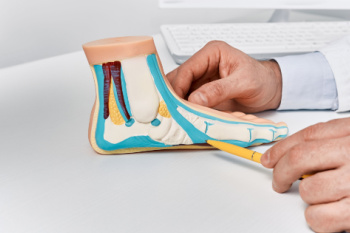
Flat feet, or fallen arches, occur when the arches of the feet collapse, causing the entire sole to touch the ground. While some individuals have flat feet from childhood, others may develop them later in life. A primary cause of flat feet is genetics. If your parents or grandparents had flat feet, there is a higher likelihood of inheriting the condition. Additionally, injuries or stress to the feet's tendons and ligaments or standing for long periods of time can lead to flat feet. Symptoms may include foot pain, swelling, and difficulty with movement. In severe cases, surgical intervention may be necessary to reconstruct the arches. To accurately diagnose the extent of flat feet and determine what the most effective treatment plan is, it is important to consult a podiatrist. They can provide expert assessment, recommend appropriate interventions like custom orthotics, and ensure ongoing management to alleviate symptoms and improve foot function. It is suggested that you schedule an appointment with a podiatrist for personalized care and relief from flat feet.
Flatfoot is a condition many people suffer from. If you have flat feet, contact Elie C. Daniel, DPM from Illinois. Our doctor will treat your foot and ankle needs.
What Are Flat Feet?
Flatfoot is a condition in which the arch of the foot is depressed and the sole of the foot is almost completely in contact with the ground. About 20-30% of the population generally has flat feet because their arches never formed during growth.
Conditions & Problems:
Having flat feet makes it difficult to run or walk because of the stress placed on the ankles.
Alignment – The general alignment of your legs can be disrupted, because the ankles move inward which can cause major discomfort.
Knees – If you have complications with your knees, flat feet can be a contributor to arthritis in that area.
Symptoms
- Pain around the heel or arch area
- Trouble standing on the tip toe
- Swelling around the inside of the ankle
- Flat look to one or both feet
- Having your shoes feel uneven when worn
Treatment
If you are experiencing pain and stress on the foot you may weaken the posterior tibial tendon, which runs around the inside of the ankle.
If you have any questions please feel free to contact our offices located in Princeton, Peru, and Mendota, IL . We offer the newest diagnostic and treatment technologies for all your foot and ankle needs.
